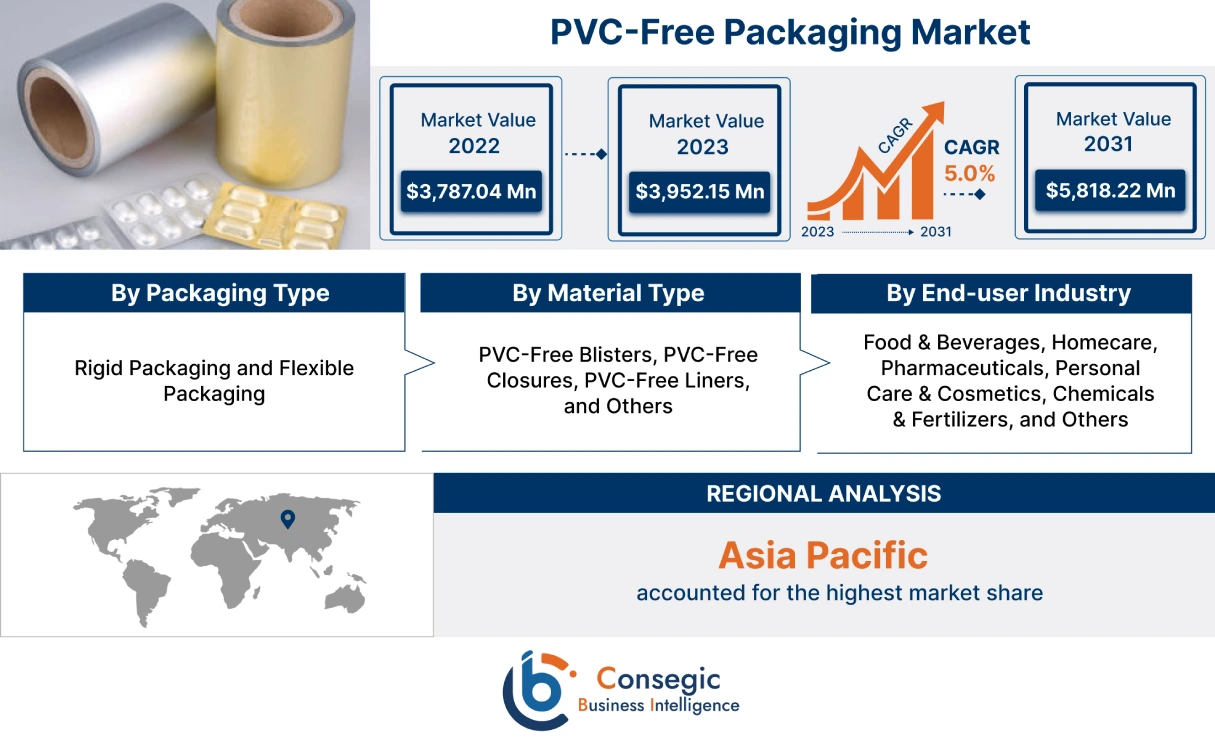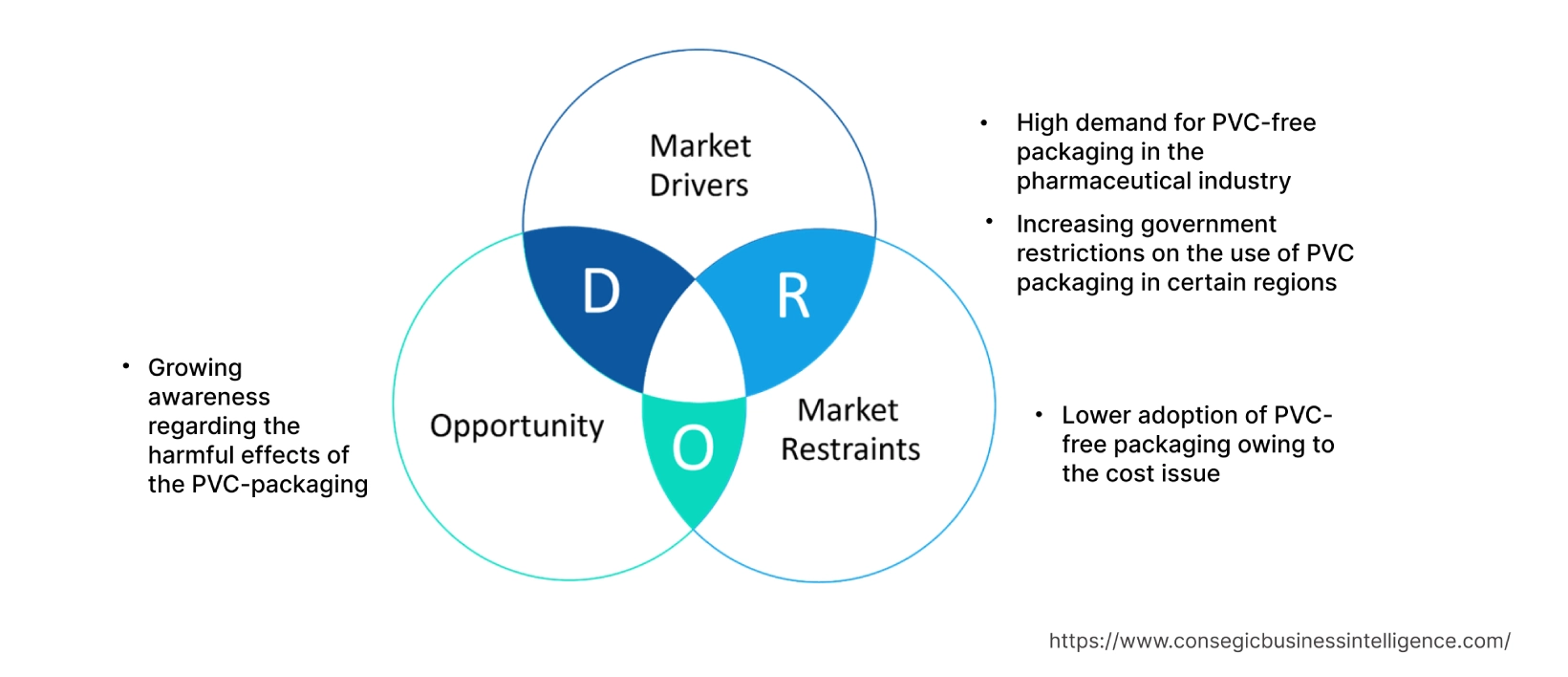PVC-Free Packaging Market Size :
Consegic Business Intelligence analyzes that the PVC-Free packaging market is growing with a CAGR of 5.0% during the forecast period (2023-2031). The market accounted for USD 3,787.04 million in 2022 and USD 3,952.15 million in 2023, and the market is projected to be valued at USD 5,818.22 Million by 2031.
PVC-Free Packaging Market Scope & Overview:
PVC-free packaging is packaging that does not contain polyvinyl chloride (PVC). PVC is a type of plastic that is commonly used in packaging because it is strong, durable, and inexpensive. However, PVC also has some environmental and health concerns. PVC-free packaging is becoming more popular due to the rising environmental concerns associated with PVC. Various materials such as paper and cardboard, glass and metals, biodegradable plasticizers, fabric and textile, wood, and textured and embossed paper are used as a substitute for PVC in the packaging industry.
PVC-free packaging finds application in various end-user industries such as food and beverages, healthcare, pharmaceuticals, homecare products, chemicals & fertilizers, and others. These types of packaging offer lower toxicity and risk of contamination due to which they are becoming highly popular across various end-user industries across the globe.
PVC-Free Packaging Market Insights :
PVC-Free Packaging Market Dynamics - (DRO) :
Key Drivers :
High demand for PVC-free packaging in the pharmaceutical industry
PVC-free packaging is highly used in the pharmaceutical industry owing to the high risk of PVC contamination, the safety of patients, changing regulatory compliances, innovations in packaging, and rising consumer awareness regarding the harmful effects of PVC packaging. Continuous research and development efforts have resulted in innovative PVC-free pharmaceutical packaging solutions that meet the specific needs of the pharmaceutical industry. The materials offer features such as temper-evident seals, moisture resistance, and protection against light, ensuring the efficacy and safety of medications. These large benefits of PVC-free packaging in the pharmaceutical industry along with the growing innovations in the development of PVC-free pharmaceutical packaging material are driving the market growth. For instance, in April 2021, Amcor Plc., a global leader in developing and producing responsible packaging solutions, announced the launch of the AmSky blister system. The new product eliminated PVC packaging from healthcare customers and improved recyclability in pharmaceutical packaging. The latest in Amcor's recent innovation breakthroughs has the potential to transform the sustainability of healthcare packaging. Hence, the high demand for packaging materials in the pharmaceutical industry along with the rising innovations in PVC-free packaging are driving the growth of global PVC-free packaging market worldwide.
Increasing government restrictions on the use of PVC packaging in certain regions
Stringent government regulations and increasing bans on PVC in certain regions and applications are improving the adoption of PVC-free packaging in several end-user industries. Packaging material made of PVC plastic is not easily biodegradable and it releases harmful chlorine gas and other toxic gases into the atmosphere when incinerated. The persistence of these PVC packaging materials in landfills can highly contaminate the soil and lead to environmental pollution. Owing to such harmful effects of PVC on both flora and fauna. Governments of various countries are imposing regulations to control the use of PVC in packaging. For instance, in June 2023, the government of Taiwan announced a ban on PVC packaging in the e-commerce sector. Under the new rules, no PVC plastic will be allowed in online retailers' packaging, while wrappers containing more than 90 percent recycled paper in natural colours or plastic packaging with more than 25% reusable plastic should be prioritized. Thus, the increasing regulations on the use of PVC-based packaging materials and the high environmental concerns about PVC are driving the global PVC-free packaging market.
Key Restraints :
Lower adoption of PVC-free packaging owing to the cost issue
PVC-free packaging products, such as bioplastics (PLA), recycled paper, polyethylene, polyethylene terephthalate, high-density polyethylene, etc. are used instead of PVC in the packaging sector. These packaging materials are high in cost due to several factors such as high production and processing costs, investment in infrastructure, high spending on research and development activities, and others. The manufacturing processes involved in the production of these materials significantly affect the cost of the product. However, the long-term durability and reduced maintenance requirements of HDPE pipes can offset the initial investment. Furthermore, the availability of these PVC-free packaging materials is also low in the global market, which reduced the adoption of materials from various potential customers worldwide. Thus, the higher cost of PVC-free packaging products reduces the adoption of these materials from small-scale or moderate consumer base industries. This lower adoption of PVC-free materials along with the low availability of specific products for different applications is hampering the growth of the PVC-free packaging market worldwide.
Future Opportunities :
Growing awareness regarding the harmful effects of the PVC-packaging
PVC packaging is a human health and environmental threat. PVC packaging is toxic in all stages of its lifecycle. PVC packaging can leach its many toxins through contact with the mouth and may also shed these particles into the air to be inhaled. The awareness of the potential health risks associated with PVC packaging is rising globally. PVC contains various harmful materials such as phthalates and lead which can be mixed with food and beverages along with PVC packaging and can lead to several health-related concerns. For instance, according to the report by the National Cancer Institute in November 2022, exposure to vinyl chloride materials is associated with an increased risk of a rare form of liver cancer (hepatic angiosarcoma), as well as primary liver cancer (hepatocellular carcinoma), brain and lung cancers, lymphoma, and leukemia. Therefore, consumers are seeking packaging that doesn't pose these risks, especially when it encounters food, beverages, pharmaceutical, cosmetics, and other products which is in direct human contact. Hence, the growing consumer awareness regarding the harmful effects of PVC packaging is expected to provide lucrative growth opportunities for the PVC-free packaging market in the upcoming years.
PVC-Free Packaging Market Report Insights :
| Report Attributes | Report Details |
| Study Timeline | 2017-2031 |
| Market Size in 2031 | USD 5,818.22 Million |
| CAGR (2023-2031) | 5.0% |
| By Packaging Type | Rigid Packaging and Flexible Packaging |
| By Material Type | PVC-Free Blisters, PVC-Free Closures, PVC-Free Liners, and Others |
| By End-user Industry | Food & Beverages, Homecare, Pharmaceuticals, Personal Care & Cosmetics, Chemicals & Fertilizers, and Others |
| By Region | North America, Europe, Asia-Pacific, Latin America, and Middle East & Africa |
| Key Players | Amcor Limited, Sacmi Group, Tekni-Plex, Inc., Constantia Flexibles Group GmbH, Selig Group, Technovinyl Polymers India Ltd., World Bottling Cap, LLC., Danburry Plastics, ACTEGA, Borealis AG, Weener Plastics, and Crown Holdings, Inc. |
PVC-Free Packaging Market Segmental Analysis :
By Packaging Type :
The packaging type is categorized into rigid packaging and flexible packaging. In 2022, the rigid packaging segment accounted for the highest market share in the PVC-free packaging market, and it is also expected to grow at the highest CAGR over the forecast period. The significant benefits of rigid packaging over other packaging types are driving the segment growth across the globe. Rigid packaging provides sturdiness and aesthetic appeal to the packaging. Various types of products such as boxes, trays, containers, cans, bottles, jars, and other formats are used in this type of packaging. In food packaging, it is used to allow for easy transport of goods, protect the integrity of food products, and ensure separation from harmful chemicals, particles, bacteria, and pests. Similarly, in the pharmaceutical industry, rigid packaging protects against the contamination of the medicines and other products contained in it. Along with the high benefits of PVC-free rigid packaging, they can be easily recycled without significant hazards to the environment. Thus, the above-mentioned factors are contributing to the segment growth worldwide.
By Material Type :
The material type segment is categorized into PVC-free blisters, PVC-free closures, PVC-free liners, and others. In 2022, the PVC-free closures segment accounted for the highest market share in the overall PVC-free packaging market. The growing innovations and launch of new and advanced materials for the development of PVC-free enclosures are driving the segment's growth. For instance, in June 2023, TotalEnergies announced the commercial launch of a new high-density polyethylene (HDPE) resin for tethered cap applications, allowing for a reduction in material usage, enhanced recovery, and improved recycling. The new HDPE 20HD07 resin has enhanced mechanical and organoleptic properties, enabling identical technical cap performances with less material than market reference, thus reducing the carbon footprint of end applications, such as beverage or cosmetic bottles. Hence, the increasing innovation in raw materials for the development of PVC-free closures is driving the segment growth.
Moreover, the PVC-free liners segment is expected to grow at the fastest CAGR over the forecast period in the PVC-free packaging market. Container liners or packaging liners are used to ensure safe packaging of products for transportation. The ability of PVC-free liners to prevent the packaged materials from contamination and holding bulk carriers is expected to drive the segment growth over the estimated period.
By End-Use-Industry :
The end user segment is categorized into food & beverages, homecare, pharmaceuticals, personal care & cosmetics, Chemicals & Fertilizers, and others. In 2022, the food & beverages segment accounted for the highest market share of 29.65% in the overall PVC-free packaging market and it is also expected to grow at the highest CAGR over the forecast period. PVC-free packaging finds various applications in the food & beverages industry owing to its safety, sustainability, and regulatory compliances. Various products such as flexible packaging materials often made from materials such as PP, PE, or multilayer structures are used for packaging a wide range of food & beverage products. Increasing focus by the key player for the launch of various PVC-free packaging products is driving the segment growth globally. For instance, in January 2023, Amcor, Plc. announced the launch of its new PrimeSeal and DairySeal Recycle-Ready Thermoforming Films for meat and dairy made from polyethylene. The new thermoformable films are transparent with a clear gloss to help demonstrate the quality of products to shoppers by creating tight, wrinkle-free packaging. Therefore, the growing innovations in PVC-free packaging in the food & beverage industry are driving segmental growth.
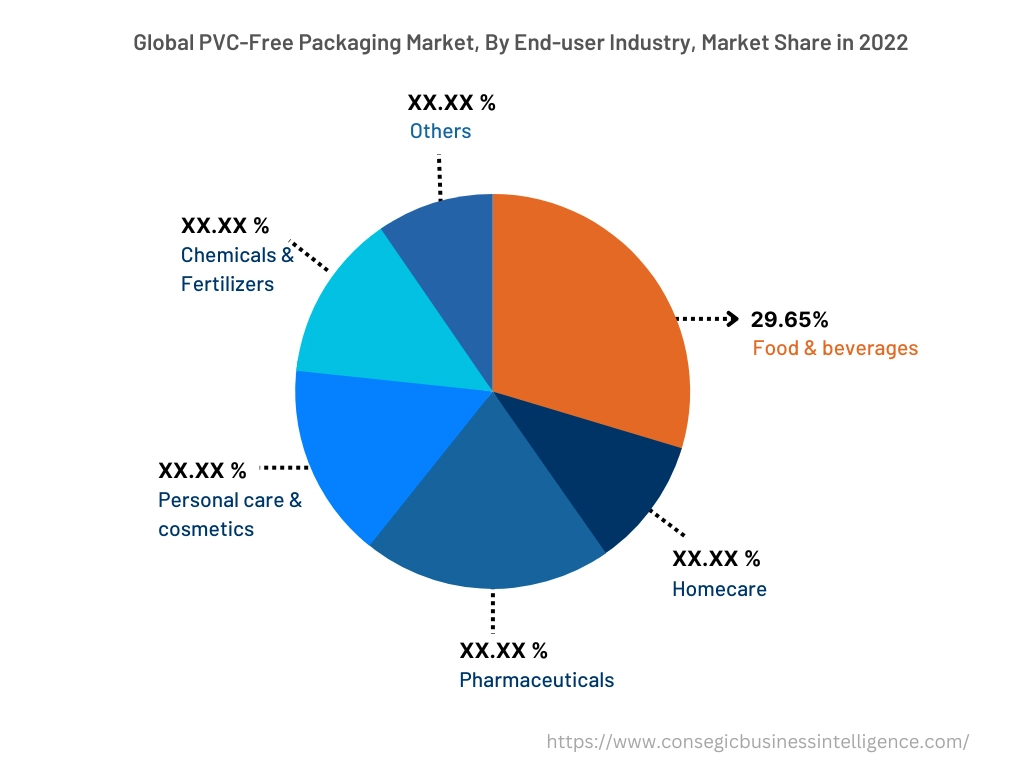
By Region :
The regional segment includes North America, Europe, Asia Pacific, Middle East and Africa, and Latin America.
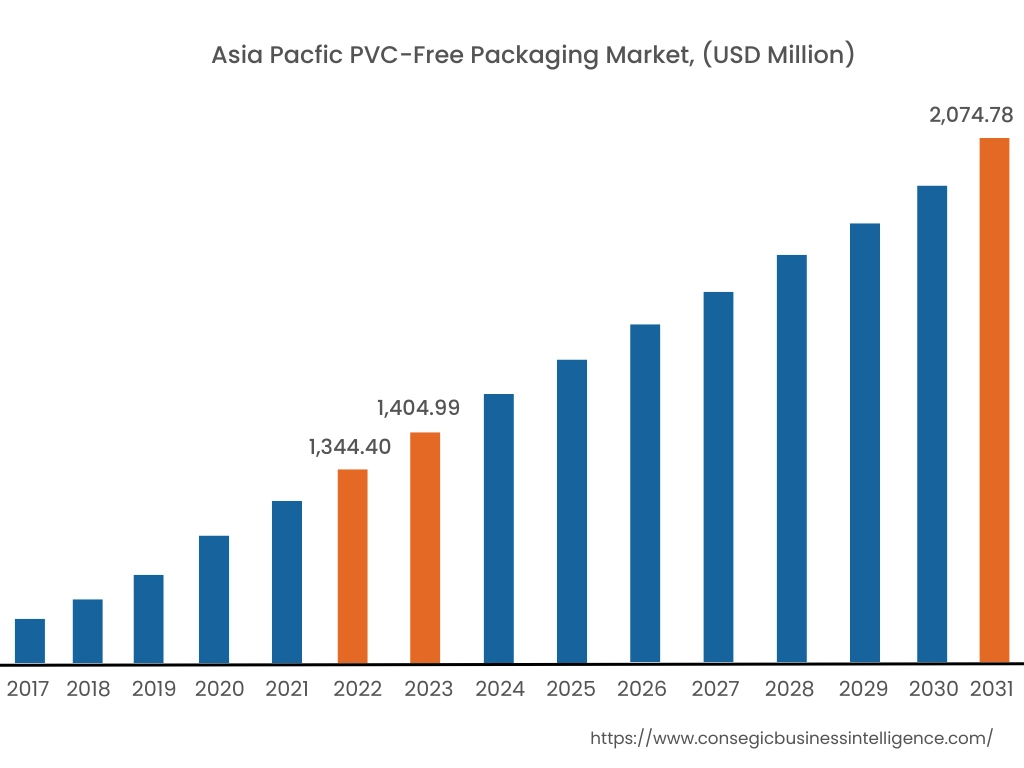
In 2022, Asia Pacific accounted for the highest market share at 35.50% valued at USD 1,344.40 Million in 2022 and USD 1,404.99 Million in 2023, it is expected to reach USD 2,074.78 Million in 2031. In Asia Pacific, China accounted for the highest market share of 23.05% during the base year of 2022. Pharmaceutical and food and beverages industries are the key consumers of PVC-free packaging materials owing to the higher contamination risk of PVC in their products. The significant growth in the pharmaceutical and food and beverages industry in the Asia Pacific region is driving market growth across the region. For instance, according to the report by the International Trade Administration in May 2020, China's food and beverage sector reached approximately USD 595 billion in 2019, a 7.8% increase over 2018. The significant growth in the food and beverage industry across the country is increasing the demand for PVC-free packaging for various packaging applications. Furthermore, significant growth in the pharmaceutical industry in Asia Pacific is driving the market growth. According to the report by the Indian Brand Equity Foundation in August 2023, the market size of the Indian pharmaceuticals industry is expected to reach USD 65 billion by 2024, and USD 130 billion by 2030.
Furthermore, the North America region is expected to witness significant growth over the forecast period, growing at a CAGR of 5.9% during 2023-20230. This is due to environmental concerns, and growing consumer awareness regarding the effect of PVC on the human body in the region. Such factors are expected to provide lucrative opportunities for the growth of the PVC-free packaging market in the North America region.
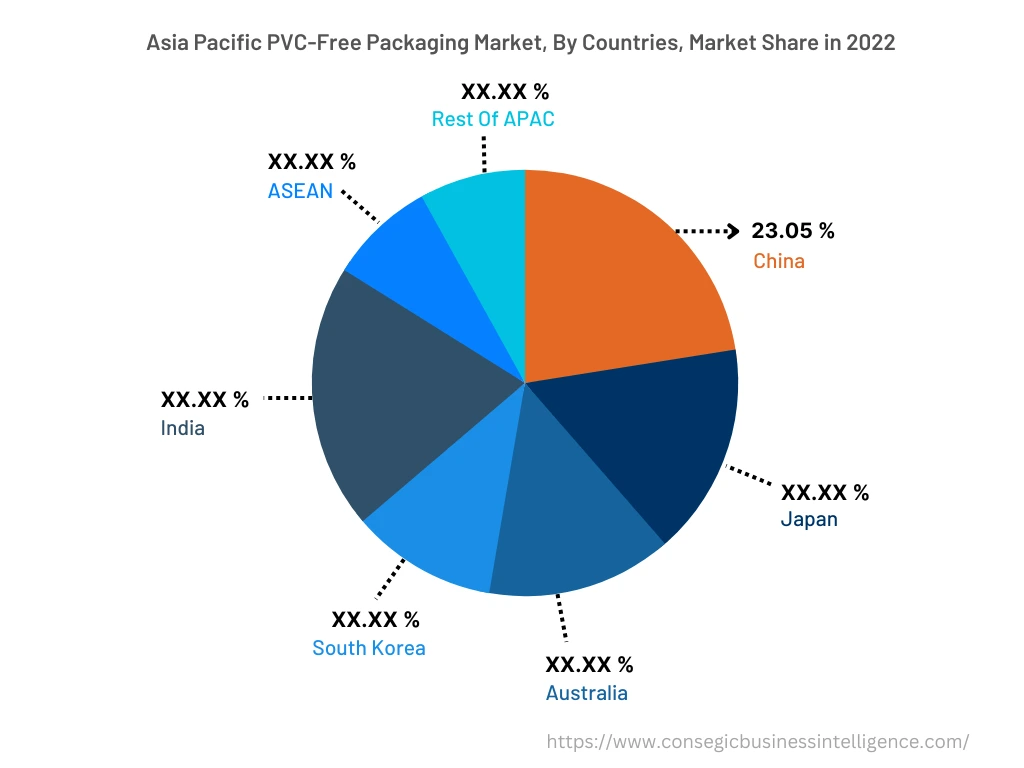
Top Key Players & Market Share Insights:
The PVC-free packaging market is highly competitive, with several large players and numerous small and medium-sized enterprises. These companies have strong research and development capabilities and a strong presence in the market through their extensive product portfolios and distribution networks. The market is characterized by intense competition, with companies focusing on expanding their product offerings and increasing their market share through mergers, acquisitions, and partnerships. The key players in the market include-
- Amcor Limited
- Sacmi Group
- ACTEGA
- Borealis AG
- Weener Plastics
- Crown Holdings, Inc.
- Tekni-Plex, Inc.
- Constantia Flexibles Group GmbH
- Selig Group
- Technovinyl Polymers India Ltd.
- World Bottling Cap, LLC.
- Danburry Plastics
Recent Industry Developments :
- In April 2023, ACTEGA, a global manufacturer of specialty coatings, inks, adhesives, sealants, and packaging materials, announced an investment of USD 5 million for the expansion of its New Jersey facility.
- In April 2021, Amcor Plc., a global leader in developing and producing responsible packaging solutions, announced the launch of AmSky blister system. The new product eliminated PVC packaging from healthcare customers and improved recyclability in pharmaceutical packaging.
Key Questions Answered in the Report
What was the market size of the PVC-free packaging industry in 2022? +
In 2022, the market size of PVC-free packaging was USD 3,787.04 Million.
What will be the potential market valuation for the PVC-Free Packaging industry by 2031? +
In 2031, the market size of PVC-free packaging will be expected to reach USD 5,818.22 Million.
What are the key factors driving the growth of the PVC-free packaging market? +
High demand for vinyl-free packaging in the pharmaceutical industry across the globe is fueling market growth at the global level.
What is the dominating segment in the PVC-free packaging market for the end-user industry? +
In 2022, the food & beverages segment accounted for the highest market share of 29.65% in the overall PVC-free packaging market.
Based on current market trends and future predictions, which geographical region is the dominating region in the PVC-free packaging market? +
Asia Pacific accounted for the highest market share in the overall PVC-free packaging market.
